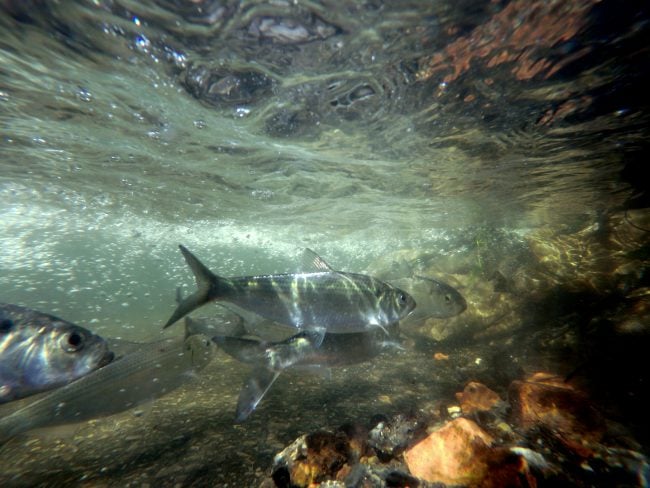Herring return to Wynants Kill after 85 years

Erica Capuana / NYS DEC Division of Fish & Wildlife
View more images on our Flickr site
Dam removal project in Troy is first of its kind in Hudson River Estuary –
part of new initiative to restore historic spawning habitat

Erica Capuana / NYS DEC Division of Fish & Wildlife
For Immediate Release June 2, 2016
Contacts
Leah Rae, Riverkeeper, [email protected], (914) 715-6821
John Salka, City of Troy, [email protected], (518) 279-7131
Lori Severino, DEC, [email protected], (518) 402-8000
Troy, N.Y. – The removal of a dam in the Wynants Kill, a Hudson River tributary, has succeeded in restoring more than a quarter mile of spawning habitat for river herring – reviving a historic spawning run for the first time in 85 years.
The project – a collaborative effort by Riverkeeper, the state Department of Environmental Conservation and the City of Troy – is the first of its kind in the Hudson River estuary. It signals the potential for many more such projects under a new state initiative.
“The restoration of historic spawning habitat is an important component of DEC’s river herring fisheries management plan,” Acting DEC Commissioner Basil Seggos said. “This barrier mitigation project is the first of its kind on a tributary of the Hudson River estuary and will also help reduce localized flooding and improve water quality.”
River herring are one of the most important species which return to the Hudson from the Atlantic to spawn. Since the 1960s, river herring populations up and down the Atlantic Coast have significantly declined due to overharvest and the loss of spawning habitat. Federal and state biologists prioritize the restoration of this habitat as one of the best ways to encourage herring stocks to recover from current historic lows.
Following the removal of a metal barrier May 4 by the City of Troy, the DEC observed hundreds of alewives, a species of herring, entering the stream. American eel, white sucker, yellow perch and other fish have also gained access to the Wynants Kill.
The dam removal was funded by the Environmental Protection Fund (EPF) through a Hudson River Estuary Program Grant for “Tributary Restoration and Resiliency,” awarded to the City of Troy in January of this year.
“We’re very proud of the City of Troy for being first in this initiative. By helping to restore life to this stream, Troy is demonstrating that communities can not only benefit from the river, they can also benefit the river in return,” Riverkeeper Captain John Lipscomb said. “The river is better off today than before Troy took this action. How many communities can say the same?”
Fish and many other organisms use tributaries to the Hudson (creeks and streams) as pathways to move between feeding, nursery, and spawning grounds. Many dams and culverts are blocking those pathways and dramatically shrinking the habitat available. Dams block fish passage, as do culverts that are too small. All affect hydrology, sediment transport, and water quality of tributaries, and cost money for local communities and the state to replace and maintain.
An interactive “Aquatic Connectivity” map, posted on the website of Cornell’s New York State Water Resources Institute, identifies areas throughout the Hudson River estuary where species would benefit from being able to pass.
“Environmental improvement efforts like the removal of the Wynants Kill Dam are critically important to maintaining a healthy Hudson River ecosystem,” said Troy Mayor Patrick Madden. “The City of Troy is very proud of our partnership with the Department of Environmental Conservation and Riverkeeper to complete this necessary environmental restoration project.”
Riverkeeper first identified the opportunity for the Wynants Kill dam removal during its Hudson River patrols, when John Lipscomb, Riverkeeper’s boat captain, alerted the DEC to a discharge from an unused mill building near the stream. Lipscomb discussed the opportunity with DEC Environmental Conservation Officers, Lieutenant James Hayes and Officer Scott Daly, who investigated by land with Lipscomb on June 5, 2013.
DEC’s Hudson River Estuary Program then provided technical, strategic and funding support to the City of Troy to assist in the removal of the dam.
“We talk about environmental damage as ‘death by a thousand cuts,’” Lipscomb said. “This heals one of those cuts – a really bad cut. The construction of the Wynants Kill barrier almost 100 years ago cut off a tributary that was owned by the herring and other species. Now it’s theirs again. That’s how the Hudson River will recover. That’s how the Hudson will be restored. By healing one cut at a time. We can be proud of this. And we need to immediately look for another opportunity.”
About DEC’s Hudson River Estuary Program
A project of the NYS Environmental Protection Fund, the Hudson River Estuary Program helps people enjoy, protect, and revitalize the Hudson River Estuary. Now in its 13th year, the Estuary Grants Program implements priorities outlined in the Hudson River Estuary Action Agenda to achieve six key benefits: clean water; resilient communities; a vital estuarine ecosystem; conservation of fish, wildlife, and habitats; preservation of the river’s natural scenery; and enhanced opportunities for education, river access, recreation, and inspiration.
For more information on the Hudson River Estuary and funding opportunities through the Hudson River Estuary Program, visit http://www.dec.ny.gov/lands/5091.html on DEC’s website.
About Riverkeeper
Riverkeeper is a member-supported watchdog organization dedicated to defending the Hudson River and its tributaries and protecting the drinking water supply of nine million New York City and Hudson Valley residents. Riverkeeper maintains an enforcement presence on the Hudson River, patrolling the length and breadth of the estuary from south of New York Harbor to north of the federal dam at Troy. Visit Riverkeeper.org.
###
Photos and video by Erica Capuana, New York State Department of Environmental Conservation Division of Fish & Wildlife

